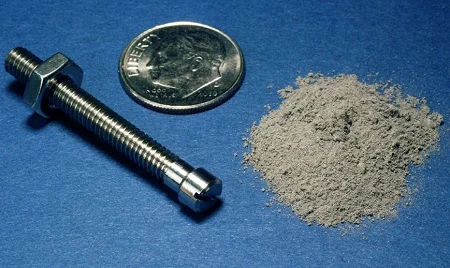From hydrogen fuel cell storage systems to next-generation solar windows and more efficient computing to marine power tech, a whole lot of significant green breakthroughs have occurred in our national laboratories.
But for the rubber to meet the road, innovative companies have to capitalize on those technologies and scale them up to meet the needs of the commercial marketplace—which is what the “America’s Next Top Energy Innovator” challenge is all about.

Hot on the heels of President Obama’s State of Union Address, which highlighted support for American innovation, Secretary of Energy Steven Chu announced the three winning startups out of the 14 finalists in the challenge.
Winners were chosen through a combination of public voting and an expert review; each of the winning teams uses breakthrough research from one of the nation’s national laboratories.
Finished 1.8 gram titanium bolt made from 1.8 grams of gas atomized titanium powder (image via IPAT)
The three teams taking top honors (each sharing the top spot) are Iowa Powder Atomization Technologies (IPAT), a startup based in Nevada, Iowa; Umpqua Energy, based in Medford, Ore.; and Vorbeck Materials, based in Jessup, Md.
IPAT is putting gas atomization technology to work that was first developed at Ames Laboratory in Iowa to make the process of developing titanium powder 10 times more efficient than the current industry standard, significantly lowering the cost of this power to manufacturers.
Titanium is strong, lightweight, biocompatible and resistant to corrosion, which makes it ideal for use in everything from artificial limbs to military vehicles, biomedical implants, aerospace fasteners and chemical plant valves. (The powder form of titanium is easier to work with than having to cast the metal with molds, and more predictable as well, since titanium has a bad habit of bonding with whatever metal is used to make the mold.)
Winner number two, Umpqua Energy, is making good on clean burn engine tech developed at Argonne National Laboratory in Illinois. This technology tricks out your average gasoline engine in a way that allows it to operate in an extreme lean burn mode, increasing gasoline mileage. And while a lean burning engine, whether gas or diesel, tends to kick out a higher level of emissions as well, Umpqua expects to both increase fuel economy and reduce emissions with its system.

Winner number three is Vorbeck Materials, which is making use of a nanotech process first developed at Pacific Northwest National Laboratory in Washington state to build better batteries. Specifically, better lithium ion batteries—the kind widely used in laptops and electric vehicles. Vorbeck is putting the laboratory’s method to work in in developing lithium air and lithium sulfur batteries that stores twice as much electricity at high charge and discharge rates as current lithium-ion batteries, and with a bigger capacity and a longer lifecycle.
The winning teams for this year’s competition won’t win any big cash prizes for their efforts, but they will be featured at a major annual gathering of clean energy investors and innovators from around the country—the 2012 ARPA-E Energy Innovation Summit, at the end of February—where they’re likely to garner some significant backing.
As part of America’s Next Top Energy Innovator challenge, the U.S. Department of Energy (DOE) cuts down on the cost and the red tape for startups wishing to obtain an option agreement to license patents and patent applications held through the department’s 17 national laboratories. Thirty-six companies have signed these option agreements so far, and DOE has just announced another round of the competition for next year.






